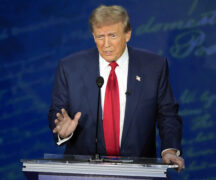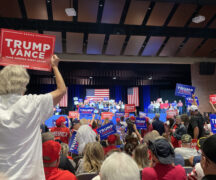Poll also looks at how voters view celebrity endorsements, direct democracy, & the Electoral College
From DEMOCRACY AND PUBLIC POLICY RESEARCH NETWORK AT BOWLING GREEN STATE UNIVERSITY
The Democracy and Public Policy Research Network at Bowling Green State University has released the findings of its October poll, a web-based poll of 1,000 likely Ohio voters conducted from Oct. 10 to 21, 2024.
The sample was split in half (500-500) for questions nine and 10, which examine voter preferences relating to Ohio Issue 1. The margin of error for those two questions is +/- 5.14 percentage points. For all other questions, the poll has a margin of error of +/- 3.6 percentage points.
The poll was conducted under the direction of BGSU professors Dr. Robert Alexander, Dr. Melissa Miller, Dr. David Jackson, and Dr. Joshua Boston in partnership with YouGov.
Topics covered in the October poll include:
- Presidential race
- Ohio U.S. Senate race
- Ohio Issue 1 and thoughts on direct democracy
- Ohioans’ thoughts on popular vote vs. Electoral College
- Ohioans’ views of celebrity endorsements
Trump continues to hold a solid lead in Ohio
Donald Trump continues to poll strongly in Ohio besting Kamala Harris by a 50 to 43 margin among likely voters. This is consistent with the 7-point margin Trump led Harris by in our September poll and aligns with his 8–point victories in Ohio in 2016 and 2020. Despite his lead, Trump continues to be a polarizing figure with 47% holding a favorable view and 47% holding an unfavorable view of him.
Harris has the lowest net favorability score at -12. Sixty percent of Ohioans say the nation’s economy has gotten worse in the last year and the economy (25%) ranks as the top issue among our respondents.
In addition to the economy, likely voters state that threats to democracy (17%), inflation (16%), and immigration (15%) are the most important issues they are thinking about for this November’s election.
“Ohio voters continue to feel frustrated about the state of the nation’s economy and that usually spells trouble for the incumbent party. Donald Trump has tapped into frustrations over the economy, inflation, and immigration and appears poised to claim an Ohio victory for a third time.”
– Robert Alexander, professor of political science, BGSU
Race between Sherrod Brown and Bernie Moreno has tightened
Ohio’s Senate race has become the most costly Senate race in the country. It is also one of the most important given how closely divided the institution is. We find Sherrod Brown with a slight edge, 47% to 45% against his opponent, Republican Bernie Moreno.
Brown finds strong support among Democrats (94%) and Independents (48%), while Moreno has room to grow among
Republicans (84%) and Independents (31%). Seven percent of voters remain undecided, including 20% of Independent voters. This is a sizable number for such a late stage in a contested campaign.
Given the headwinds against Brown, he will need to rely on a significant number of split-ticket voters if he is to win another term in the United States Senate.
“The contest between Brown and Moreno has continued to tighten and is clearly up for grabs. It has been impossible for voters in the state to escape the glut of campaign advertising–suggesting just how important this race is on a national scale.”
– Robert Alexander, professor of political science, BGSU
Awareness grows as Ohio Issue 1 tightens
October results suggest growing awareness of Ohio Issue 1 in the campaign’s final stretch. Issue 1 would replace the Ohio Redistricting Commission with a citizen’s commission to draw state legislative and congressional districts.
While in September nearly 3 in 10 likely voters had heard nothing about Issue 1, now just 10 percent have heard nothing about it. As in September, Issue 1’s proponents have the advantage, but that edge has narrowed over the past month. The proportion planning to vote yes on Issue 1 has dropped from 60 percent in September to approximately 56.5 percent in October.
Partisan battlelines have also come into clearer focus on Issue 1, with October results showing roughly 9 in 10 Democrats backing the ballot measure versus about 3 in 10 Republicans opposing it.
“As Election Day nears, a tightening on Issue 1 is no surprise. Voters have been swamped for weeks with candidate advertising in Ohio. Only now is messaging on Issue 1 breaking through.”
– Melissa Miller, professor of political science, BGSU
***
“The partisan split on Issue 1 is striking. Proponents of the measure no doubt hope that Democrats will turn out in high numbers and a majority of independents will break in favor.”
***
“One of the wildcards is how the lengthy summary ballot description of Issue 1 will influence both participation in the race and its outcome. Ballot drop-off could be high once voters confront pages of text to read at the end of their ballot. As such, Issue 1 will likely be decided by only the most committed voters on either side of the issue.”
Ohio voters like direct democracy
The use of direct democracy in the state has become a key feature in Ohio politics. Voters rejected an attempt to limit direct democracy by soundly defeating Issue 1 in August of 2023 which would have made it more difficult to put place state constitutional amendments on the ballot and pass them through direct democracy measures. Months later, voters enshrined abortion rights in the Ohio Constitution and voted to legalize recreational marijuana through direct democracy.
We find Ohioans overwhelmingly support direct democracy as a means to engage in citizen lawmaking. For instance, 62% agree that direct democracy is a good thing, 74% believe it is an important tool to hold government accountable, 70% agree that it is an important tool to keep special interests from having too much power, and 71% agree that it is important for citizens because government officials are not doing a good job of representing the people.
“Ohio voters have always been a little suspicious of too much government power. It would appear that many believe that citizen lawmaking through direct democracy provides a means for a ‘citizens’ check’ upon the power of governmental leaders. I think it is fair to expect we will continue to see important ballot measures face Ohio voters in future contests.”
– Robert Alexander, professor of political science, BGSU
Celebrity Influence in Ohio: Party Matters
Overall, the celebrities we studied appear to be a net reducer of enthusiasm for a presidential candidate, or a net neutral, with Harris endorsers Taylor Swift and Oprah Winfrey having the largest net negative effects on enthusiasm at -10 and -9 points, respectively.
Kid Rock is a two point net negative on enthusiasm for Trump, while Elon Musk’s effect is completely even, with 22% of respondents saying his endorsement makes them more enthusiastic about Trump and 22% saying it makes them less enthusiastic.
These results are not surprising, given that the sample is +7 in favor of Donald Trump and +5 for Republican party identification. Among Democrats only, Taylor Swift’s endorsement has a +23 effect, making them more enthusiastic for Harris and Oprah Winfrey has a +24 effect. Among Republicans only, Elon Musk is at a +36 effect making them more enthusiastic for Trump and Kid Rock is at a +22.
“Republicans feel more enthusiastic about their candidate when a celebrity endorses them and Democrats feel more enthusiastic about their candidate when a celebrity endorses them. This suggests at this point in the election, celebrities are probably more effective at motivating turnout among partisans than they are at persuading undecided voters.”
– David J. Jackson, professor of political science, BGSU
Fifty-six percent of respondents agree or strongly agree that celebrities should stay out of politics. Even this is influenced by party preference, with 55% of Republicans strongly agreeing, 38% of Independents strongly agreeing, but only 15% of Democrats doing so.
“Ohio Republican likely voters seem to be of two minds regarding celebrity involvement in politics. They helped elevate celebrity Donald Trump directly to the presidency, and the party has renominated him for the nation’s highest office. They also seem to like Elon Musk and Kid Rock endorsing their candidate. On the other hand, they say they want celebrities to stay out of politics.” – David J. Jackson, professor of political science, BGSU
Ohioans have somewhat surprising views on the Electoral College
A majority of our respondents would prefer a national popular vote (54%) compared to the current Electoral College system (35%). Ohioans show a number of concerns with the Electoral College process. Seventy-three percent are concerned state legislatures could overturn a state’s popular vote, 70% are concerned Congress could overturn results of the Electoral College, 64% are concerned that some states could allocate their electoral votes to the winner of the national popular vote, and 62% are concerned that “faithless electors” could occur when the Electoral College meets in December.
A majority (53%) express concern that less populated states have disproportionate influence on outcomes and a similar number (54%) have concerns that campaigns spend too much time in a small number of battleground states. Sixty-two percent express concern that the popular vote winner does not always win presidential elections due to the Electoral College system. Surprisingly, just 41% are concerned that Ohio may lose its swing state status in future presidential elections.
“We find a large number of Ohioans have significant fears that problems may result due to processes related to the Electoral College. These concerns are no doubt colored by events that unfolded surrounding the 2020 election.”
– Robert Alexander, Robert Alexander, professor of political science, BGSU
Click to view supporting data:





